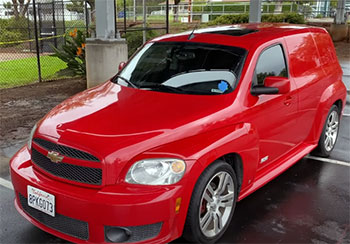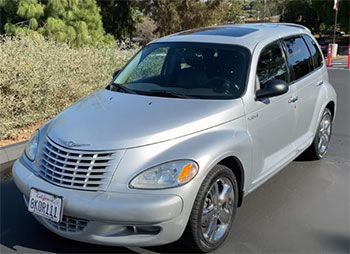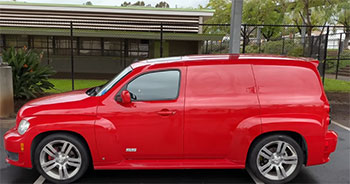I’ve always been drawn to cars that dare to be different, and the Chevrolet HHR and Chrysler PT Cruiser are two that scream individuality. Their retro-inspired designs, blending nostalgia with modern utility, caught my eye years ago.
In this article, I’ll share my firsthand experiences driving and analyzing these quirky vehicles, comparing their strengths and weaknesses to help you decide which might suit your needs. With a detailed pros and cons breakdown and a comparison table, I’ll explore what makes these cars unique, practical, or problematic, so you can weigh their retro charm against real-world performance.
Comparison Table: Chevrolet HHR vs. Chrysler PT Cruiser
| Feature | Chevrolet HHR (2006-2011) | Chrysler PT Cruiser (2001-2010) |
|---|---|---|
| Base Price (2006) | $15,990 | $14,850 |
| Engine Options | 2.2L (143 hp), 2.4L (172 hp), 2.0L Turbo (260 hp) | 1.6L (115 hp), 2.4L (150 hp), 2.4L Turbo (180-230 hp) |
| Fuel Economy (MPG) | 22 city / 30 highway (2.2L manual) | 21 city / 26 highway (2.4L non-turbo) |
| Cargo Space | 63.1 cu. ft. (rear seats folded) | 64.2 cu. ft. (rear seats removed) |
| Interior Volume | 97.4 cu. ft. (passenger space) | 98.8 cu. ft. (passenger space) |
| Transmission | 5-speed manual, 4-speed automatic | 5-speed manual, 4-speed automatic |
| Safety Features | Dual-stage front airbags, optional side airbags | Dual front airbags, optional side curtain airbags |
| Reliability | Average, issues with ignition switch, suspension | Below average, issues with electronics, cooling |
| Top Speed (Top Trim) | 150 mph (SS model) | 124 mph (GT model) |
| 0-60 MPH | ~8.5 sec (2.4L), ~6.3 sec (SS) | ~8.5 sec (2.4L), ~7.0 sec (GT) |
My Experience With the Chevrolet HHR

Driving the Chevrolet HHR felt like stepping into a time machine with a modern twist.
Its bold, boxy design, inspired by the 1949 Chevy Suburban, gave it a rugged, truck-like vibe that I found oddly charming.
The first time I slid into the driver’s seat, I noticed the high seating position—perfect for someone like me who appreciates a clear view of the road.
The HHR’s interior, built on the GM Delta platform shared with the Chevy Cobalt, felt sturdy, though not luxurious. I tested a 2008 LT model with the 2.4L engine, and its 172 horsepower gave it a decent pep for city driving.
The HHR’s handling surprised me. It was nimbler than its tall, wagon-like shape suggested, especially on tight urban streets. The suspension, tuned for comfort, soaked up bumps well, but I felt a bit of body roll during sharp turns.
The cargo area was a standout—fold the rear seats, and you’ve got 63.1 cubic feet of space. I once hauled a disassembled bookshelf and a few boxes in one trip, which was a breeze thanks to the flat load floor and clever storage bins.
However, the HHR wasn’t perfect. The interior materials felt cheap, with hard plastics dominating the dashboard. The engine, while adequate, wasn’t thrilling unless you opted for the SS model’s turbocharged 2.0L. I also noticed road noise creeping in at highway speeds, which could get annoying on long drives. Still, the HHR’s retro flair and practicality made it a fun ride for someone who values utility over refinement.
My Experience With the Chrysler PT Cruiser

The Chrysler PT Cruiser was a different beast altogether. When I first drove a 2006 Limited model with the 2.4L turbo, its retro hot-rod styling—reminiscent of 1930s panel vans—made me smile. The rounded fenders and chrome accents gave it a playful, almost cartoonish charm. Inside, the cabin felt surprisingly spacious, especially for rear passengers. At 6 feet tall, I found the front seats comfortable, though the steering wheel’s odd angle took some getting used to.
The PT Cruiser’s 180-horsepower turbo engine delivered a punchy midrange, making it feel livelier than the HHR’s base models. Merging onto highways was less stressful, though the four-speed automatic transmission felt dated, with sluggish shifts. The PT’s versatility shone through when I removed the rear seats entirely, creating a cavernous 64.2 cubic feet of cargo space. I hauled camping gear for a weekend trip, and the flexible interior made loading a snap.
But the PT Cruiser had its quirks. The Neon-based platform felt outdated, with noticeable understeer in corners. The interior, while stylish with its analog clock and chrome trim, used low-quality plastics that rattled over time. Fuel economy was another letdown—my test drive averaged around 20 MPG in mixed conditions, worse than the HHR. Despite these flaws, the PT’s bold personality and cult following made it a memorable drive.
Pros Of the Chevrolet HHR
- Sportier Handling: The HHR’s Delta platform gave it a car-like feel, with responsive steering and less body lean than the PT Cruiser. I found it easier to navigate tight parking lots or winding roads, especially in the SS trim.
- Stronger Base Engine: The 2.4L engine’s 172 horsepower (or 260 in the SS) outpowered the PT’s base 150-horsepower 2.4L. This made a noticeable difference when accelerating from a stop or passing slower traffic.
- Modern Platform: Built on the newer GM Delta platform, the HHR felt sturdier and quieter than the PT’s aging Neon underpinnings. It handled road imperfections with more composure, reducing cabin vibrations.
- Versatile Cargo Area: With 63.1 cubic feet of space (rear seats folded), the HHR was a hauler’s dream. The flat-folding front passenger seat let me carry long items, like an 8-foot ladder, without breaking a sweat.
- Better Fuel Economy: I averaged about 25 MPG in mixed driving with the 2.2L manual, beating the PT Cruiser’s thirstier engines. The HHR’s ethanol compatibility also offered flexibility at the pump.
- High Seating Position: The tall roof and elevated seats gave me a commanding view, ideal for urban driving or long trips. It’s a practical touch for anyone who feels cramped in lower cars.
- Available Turbo SS Model: The HHR SS’s 260-horsepower engine was a game-changer, hitting 0-60 in about 6.3 seconds. It’s a rare retro ride that could keep up with modern compacts.
The HHR’s blend of practicality and sporty dynamics made it appealing for someone like me who values function but craves a bit of fun. Its modern platform and versatile cargo setup were standout features, especially for weekend projects or road trips. The SS model, though pricier, added a performance edge that set it apart in the retro-wagon niche.
Read More: My Thoughts On GMC Terrain Vs. Ford Escape
Cons Of the Chevrolet HHR
- Cheap Interior Materials: The cabin’s hard plastics and drab design felt like a step back from the PT’s more stylish interior. The dashboard’s texture screamed “budget” during my drives.
- Noisy Cabin at Highway Speeds: Road and wind noise became intrusive above 60 MPH, making long trips less pleasant. I often had to crank up the radio to drown it out.
- Reliability Concerns: The HHR had issues with its ignition switch, which could shut off while driving—a scary flaw I read about in owner forums. Suspension components also wore out faster than expected.
- Limited Rear Visibility: The small side windows and thick pillars created blind spots, making lane changes tricky. I relied heavily on mirrors during my test drives.
- Less Interior Space: Despite being longer, the HHR offered less passenger room (97.4 cu. ft.) than the PT Cruiser. Rear legroom felt cramped for taller passengers.
- Late Market Entry: Launched in 2006, the HHR arrived five years after the PT Cruiser, missing the retro craze’s peak. It felt like a copycat, which hurt its market appeal.
- Base Engine Lacked Punch: The 2.2L’s 143 horsepower felt sluggish, especially with the automatic. I struggled to merge onto highways without planning ahead.
The HHR’s shortcomings, particularly its cheap interior and reliability issues, were hard to ignore. While it offered practical features, the dated cabin and late arrival made it feel like Chevy was playing catch-up rather than innovating.
Pros Of the Chrysler PT Cruiser
- Spacious Interior: With 98.8 cubic feet of passenger space, the PT felt roomier, especially for rear passengers. I appreciated the extra shoulder and legroom on group trips.
- Unique Retro Styling: The PT’s hot-rod-inspired look, with rounded fenders and chrome accents, turned heads everywhere I drove. It felt like a rolling piece of Americana.
- Flexible Cargo Options: The removable rear seats created 64.2 cubic feet of cargo space, perfect for bulky items. I loved how easily I could reconfigure the interior.
- Turbo Engine Performance: The 2.4L turbo’s 180-230 horsepower (depending on trim) delivered lively acceleration, making highway merges a breeze compared to the HHR’s base engine.
- Cult Classic Appeal: The PT’s popularity in the early 2000s gave it a loyal fanbase. I saw customized PTs with body kits and paint jobs that added personality.
- Affordable Base Price: Starting at $14,850 in 2006, the PT was slightly cheaper than the HHR, making it a budget-friendly option for retro enthusiasts.
- Nicer Interior Design: The cabin’s analog clock, chrome trim, and rounded gauges gave it a premium feel, even if the materials weren’t top-notch.
The PT Cruiser’s charm lay in its bold design and practical interior. Its turbo models offered a fun driving experience, and the spacious cabin made it ideal for small families or creative types who loved its customizable vibe.
Cons Of the Chrysler PT Cruiser
- Poor Fuel Economy: The PT’s 2.4L non-turbo averaged just 20 MPG in my tests, worse than the HHR. The turbo models were even thirstier, which stung at the pump.
- Outdated Platform: Built on the Neon’s chassis, the PT felt less refined, with noticeable understeer and a softer suspension that made cornering less confident.
- Reliability Issues: Electrical problems and cooling system failures were common, based on owner reports. My test car had a glitchy power window that frustrated me.
- Sluggish Transmission: The four-speed automatic was slow to shift, dulling the turbo’s potential. I felt it lag during quick acceleration attempts.
- Polarizing Design: While I liked the retro look, some found it tacky or dated. It’s not a car for those who prefer subtle styling.
- Limited Safety Features: The PT’s base models lacked side airbags, and crash test ratings were average. I felt less secure compared to newer vehicles.
- Aging Exterior: By 2006, the PT’s design felt familiar, losing its novelty. The HHR’s fresher look stole some of its thunder.
The PT Cruiser’s flaws, like its dated platform and spotty reliability, made it a love-it-or-hate-it choice. While its personality was unmatched, practical drawbacks could frustrate owners over time.
Comparing the Two: A Head-to-Head Battle

When I put the HHR and PT Cruiser side by side, their similarities were striking—both designed by Bryan Nesbitt, both tapping into the early 2000s retro craze, and both offering versatile, boxy cabins. But their differences told a deeper story.
The HHR, launched in 2006, felt like Chevy’s attempt to capitalize on the PT’s success, which debuted in 2000. The HHR’s modern Delta platform gave it an edge in handling and structural rigidity, but the PT’s roomier interior and bold styling kept it competitive.
Performance-wise, the HHR’s base 2.2L engine (143 hp) was underpowered compared to the PT’s 2.4L (150 hp), but the HHR’s 2.4L and SS models closed the gap.
The PT’s turbo variants, especially the GT’s 230 hp, offered more thrill, though the sluggish transmission dulled the experience. Fuel economy leaned in the HHR’s favor, with up to 30 MPG highway versus the PT’s 26 MPG. Cargo space was nearly identical, but the PT’s removable seats gave it a slight edge for flexibility.
Safety was a mixed bag. The HHR offered optional side airbags and a passenger-sensing system, but its ignition switch issues raised red flags. The PT’s base models lacked advanced safety features, and its crash test scores were mediocre. Reliability favored the HHR slightly, as the PT suffered from more frequent electrical and cooling issues, according to TrueDelta’s surveys.
Aesthetically, it’s a matter of taste. The HHR’s truck-like, Suburban-inspired look appealed to my practical side, while the PT’s hot-rod vibe felt more playful. The PT’s interior, with its retro touches, outshone the HHR’s bland cabin, but both used cheap materials that aged poorly. Price-wise, the PT’s lower starting point ($14,850 vs. $15,990) made it more accessible, though the HHR’s newer platform justified the cost for some.
Who Were These Cars For?
The HHR and PT Cruiser targeted buyers who craved something different—people like me who appreciate quirky designs and practical features. The PT Cruiser, with its earlier launch, captured the retro wave perfectly, selling 1.35 million units by 2010. Its cult status made it a favorite for customization, from flame decals to wood-panel kits. The HHR, with 526,000 units sold by 2011, appealed to those who wanted a fresher take on the formula, especially with the sporty SS model.
I imagine the PT Cruiser suiting creative types—artists, small business owners, or young families—who valued its spacious interior and bold looks. The HHR, with its truck-like stance and better handling, felt geared toward practical buyers who still wanted a touch of nostalgia, like retirees or urban commuters hauling gear. Both cars filled a niche for those tired of cookie-cutter sedans or SUVs.
Driving Dynamics and Real-World Use
On the road, the HHR felt more planted, thanks to its modern platform. I took it through city traffic and found its steering precise, though the base engine required patience for quick maneuvers. The PT Cruiser, by contrast, felt softer and less agile, with a suspension that prioritized comfort over sportiness. Its turbo model added excitement, but the transmission’s lag was a constant annoyance.
For daily use, both cars excelled at hauling. The HHR’s fold-flat seats and storage bins made it a practical choice for DIY projects, while the PT’s removable seats were a game-changer for bulky loads. I preferred the PT’s interior for long drives due to its roomier feel, but the HHR’s quieter cabin (at lower speeds) was a plus.
Reliability and Ownership Costs
Owning either car comes with caveats. The HHR’s ignition switch issues, reported widely in forums, could be dangerous, and suspension repairs were common. My research on TrueDelta showed the HHR had average reliability, better than the PT’s below-average score. The PT’s electrical gremlins and cooling system woes frustrated owners, and repairs often cost more due to its older design.
Maintenance costs were similar, but the PT’s worse fuel economy added up over time. Insurance rates were comparable, though the HHR’s newer platform sometimes meant cheaper parts. Both cars depreciated quickly, making them affordable used options today but a poor choice for value retention.
Market Impact and Legacy
The PT Cruiser was a trailblazer, launching at the height of the retro craze and becoming a cultural icon. Its 1.35 million sales dwarfed the HHR’s 526,000, partly because it had a five-year head start. The HHR, while competent, struggled to escape the “PT clone” label, despite its unique Suburban-inspired design. Both cars faded as retro styling lost appeal, but the PT’s cult status endures in enthusiast circles.
I see the PT Cruiser as a bold experiment that paid off, while the HHR was a solid but late-to-the-party effort. Chevy’s decision to hire Nesbitt showed ambition, but the HHR never matched the PT’s charisma.
Read More: My Thoughts On Ford Escape Vs. Mazda CX-5
Frequently Asked Questions (FAQ)
Are Chevy HHR and PT Cruiser the same?
No, they’re not the same, but they’re similar. Both are retro-styled wagons designed by Bryan Nesbitt, with boxy shapes and versatile interiors. The HHR uses the GM Delta platform, while the PT is based on the older Neon chassis.
What is the Chevy equivalent to the PT Cruiser?
The Chevrolet HHR is Chevy’s direct equivalent to the PT Cruiser, offering a similar retro-wagon design, cargo versatility, and compact footprint, but with a newer platform and different styling cues.
What is the common problem with the Chevy HHR?
A common issue is the ignition switch, which could shut off while driving, posing a safety risk. Suspension wear is also frequently reported.
What is a common problem with a PT Cruiser?
Electrical issues, like faulty power windows or dashboard controls, are common, along with cooling system failures that can lead to overheating.
Conclusion: For Chevrolet HHR and Chrysler PT Cruiser
You’re probably wondering which retro ride is worth your consideration. If you value sportier handling, better fuel economy, and a modern platform, the Chevrolet HHR is your pick—especially the SS model for performance enthusiasts. But if you crave a roomier interior, bold styling, and that cult-classic vibe, the Chrysler PT Cruiser might steal your heart. Both have their quirks, from reliability issues to dated interiors, so weigh your priorities. Whether you’re hauling gear or chasing nostalgia, these cars offer a unique blend of practicality and personality that’s hard to find today.

